Thumbnail data center
The desire to optimize the cost of building a data center and put it into operation faster, to get an adaptable and expandable infrastructure during the period of the so-called digital transformation, has led to an increase in the popularity of modular infrastructure solutions. One of the directions in the evolution of such solutions is micro- and mini-data centers. These compact solutions are especially attractive for small and medium-sized businesses, where often there are no rooms, even under the usual server room. Therefore, some manufacturers, including Russian ones (for example, Depo Computers, RSK, GreenMDC, etc.), began to produce cabinets with all the necessary additional equipment, which they market on the market as mini or micro data centers.

A micro (mini) data center is a complex consisting of one (micro data center) or several interconnected (mini data centers) racks, equipped with all the infrastructure necessary for the operation of IT equipment and pre-assembled and tested by the manufacturer.
These data centers are mainly designed to accommodate computing power and telecommunications equipment in unprepared premises, such as offices, warehouses, utility rooms or industrial premises. According to the vendors, the installation time for their use is reduced to 60-70% compared with the classic solution.

Over the past decade, micro-data centers in a container have been developed by leading foreign manufacturers (mainly suppliers of server hardware) and a number of domestic system integrators.
The advantages of micro-data centers, many of which can be placed in a small cabinet, are also attributed by the manufacturers to configuration flexibility, usually meaning the possibility of creating a customized solution to customer requirements, and the shortest time for manufacturing and delivery. This is a comprehensive product, a solution “from one source”: all the elements necessary for installation are included in the delivery package, which eliminates the complexity of installation, commissioning and integration. Equipment from one manufacturer (or partners) provides a high degree of system integration. In addition, such a kit undergoes preliminary testing of systems before being sent to the customer.

Trends in the development of the global mini-data center market (according to MarketsandMarkets). The projected market growth is up to $ 6.3 billion in 2020. The growth rate is up to 29.8% per year. Largest markets: North America, China, India, Brazil.
Abroad, this direction is considered quite promising. Allegedly, such complexes are in great demand in the West. So, given the progress in the field of the Internet of Things (IoT), micro-data centers are becoming an interesting tool for processing data generated by IoT solutions. Placing a micro-data center near a data source reduces transmission delays and network bandwidth requirements, which is important when there is a rapid increase in the number of devices connected to the network.

Boundary computing platforms, the role of which micro-data centers can play, allow you to distribute the load and bring computing power closer to the data source, reduce network latency.
Micro data centers are designed to minimize capital costs, optimize data center space utilization and energy consumption, and increase deployment speed. Several trends have led to this architecture:
Often, micro-data centers are equipped with built-in uninterruptible power supplies (UPS) and infrastructure management software packages (DCIM). These solutions can be deployed both in ordinary offices and in more aggressive environments.

Micro- and mini-data centers belong to the category of small systems.
Usually, each of them includes the cabinet itself, as well as cooling, monitoring, fire extinguishing, power management and protection systems. This is a kind of autonomous data center, characterized by a high level of security and sufficient cooling capacity. And thanks to the lightweight design, such a mini-data center can be installed in places with low bearing capacity of floors.

The main elements of the micro- (mini-) data center (according to Huawei): fire extinguishing, cooling, monitoring, UPS, power distribution, input-output, security subsystem.
The micro-data center may also contain: a power distribution system with “smart” PDUs (in addition to actually measuring energy consumption, they can support temperature and humidity sensors in the rack), an automatic gas fire extinguishing system, an access control and management system (ACS) and other systems (in depending on the supplier).
Execution may be different. For example, Rittal's modular micro data centers are real safes. They protect against fire, liquids, dust, breaking and corrosive gases. The safe is supplied with an air conditioning system installed at the factory, an optional system based on inverter technology is delivered, which allows you to save up to 40% of energy by adjusting the power according to need. If necessary, the safe can be additionally equipped with alarm systems, fire extinguishing, uninterruptible power supply, monitoring, etc.

Rittal Modular Micro Data Center. The developers attribute the following to its advantages:
1. Saving costs and time (there is no need to equip the available space in the building to the level of the server room);
2. Flexibility (modular layout, suitable even for hard-to-reach objects).
3. Long-term investments (opportunities for reassembly and transportation);
4. Physical protection (the solution provides protection against fire, water, dust, smoke and external access);
5. Effective cooling with well-thought-out routing of air flows and temperature control at the inlet to the server, adjustable inverter output power);
6. Fire alarm and active fire fighting in the server rack;
7. Reliable monitoring.
A small data center can also be assembled from a series of cabinets, on the basis of which it is easy to organize a server, micro-data center for a small company, and a mini data center for an average organization.
Since critical IT services can be deployed on the basis of micro-data centers, a high level of fault tolerance can be ensured, in particular, all major engineering systems (power supply, cooling) can be backed up according to the N + 1 scheme (and higher). The office complex where the micro-data center is deployed may not be equipped with a backup DGU, therefore, the micro-data center must provide autonomous power in the event of an accident for 10-30 minutes.

Micro data center is an autonomous, secure computing system, assembled and tested in the factory. Such data centers supplied include all the necessary equipment to provide power, cooling, security and management tools (DCIM).
Micro data center developers use different cooling technologies. Usually they proceed from the condition of minimizing the area occupied by the cooling system, as well as reducing the total cost of ownership and improving energy efficiency.

The main global manufacturers of mini- and micro-data centers (according to the agency MarketsandMarkets).
In order to constructively look like a single complex, engineering equipment of micro-data centers is usually placed in the same racks as IT systems. It is also possible to install elements of engineering infrastructure, such as a UPS, in the same racks with IT equipment. At the same time, designers are trying to minimize the space occupied by engineering systems, including UPS, battery, cooling system.
Among the advantages of the solutions under consideration include scalability, compactness and energy efficiency, rapid deployment, simple management, security. This is a standardized solution, an economical solution.
An important advantage of micro-data centers is the ability to deploy additional computing power in ordinary offices and at other sites without specialized supporting infrastructure. This reduces the capital costs associated with the expansion of existing data centers.
We list the main advantages of such solutions (according to Huawei).
The micro-data center can be delivered to the operating site with racks, UPSs, energy distribution, cooling and control systems in a pre-installed form and ready for deployment.
Over the past decade, a number of interesting developments in the field of mini- and micro-data centers have been presented on the Russian market.
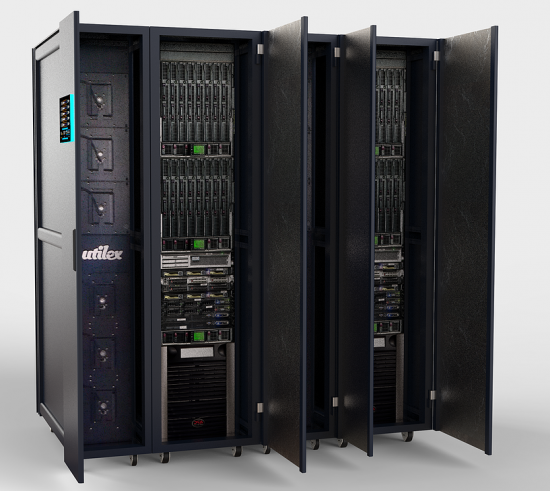
Russian-made micro-data centers are developed by ETegro Technologies, Svyaz Engineering and Utileks.
For example, ETegro micro-data center is built on the basis of the DataStone + modular solution and combines 19-inch racks with integrated Utverlex Clever Breeze air conditioning systems. A typical micro-data center solution consists of two 42U noise-proof sealed enclosures with inter-row precision air conditioners located between them.
This is a closed, sealed, soundproofed complex with protection class IP65.
IT infrastructure - ETegro Hyperion servers, ETegro Fastor storage systems and ETegro Eos switches. The system uses double conversion UPSs of Svyaz Engineering, the battery life is 15 minutes. System redundancy level N + 1. This decision was announced in 2015 as an effective and economical way to create a private cloud or a ready-made IT infrastructure for small enterprises, branches and representative offices of geographically distributed companies. As the creators promised, the creation of a completely ready-to-operate infrastructure anywhere in Russia will require no more than 12 weeks.
In subsequent years, based on the development experience of this typical micro data center, Utilexcreated a whole line of mini and micro data centers. These are mainly modular systems with the possibility of further expansion. Among them is the DataStone Mini “supermicro-data center”, designed to accommodate any 19-inch IT equipment up to 27U and power up to 2.5 kW. It has a protection class - IP54, noise isolation (18 dBA), and the cooling system is implemented on the basis of built-in fans with dust filters. There is also the possibility of installing a remote monitoring system via TCP / IP, SNMP, RS485 (Modbus RTU).

Applications DataStone Mini - server room replacement, private cloud infrastructure.
The advantages of this solution, developers include saving capital costs, short deadlines for creating a data center, high fault tolerance, the ability to move it and remote control.

Utilex DataStone + modular micro-data center is designed to accommodate and provide the required availability of computing, network equipment, storage systems, as well as any active and passive equipment. The solution with protection class IP65 has a closed cooling system (it is possible to build a cooling system with full 2N redundancy) and supports up to 30 kW of IT load per cabinet.
The RSK Tornado mini-data center also includes all the necessary structural components: 1-2 computing racks (with Intel processors, Infiniband interconnect), a cooling and power supply system, a communication subsystem, a control server and an indication system (a pump station, station is located in an adjacent cabinet water treatment, network equipment and storage). Such systems are deployed at Roshydromet, MIPT. Preparation of premises for them is not required.
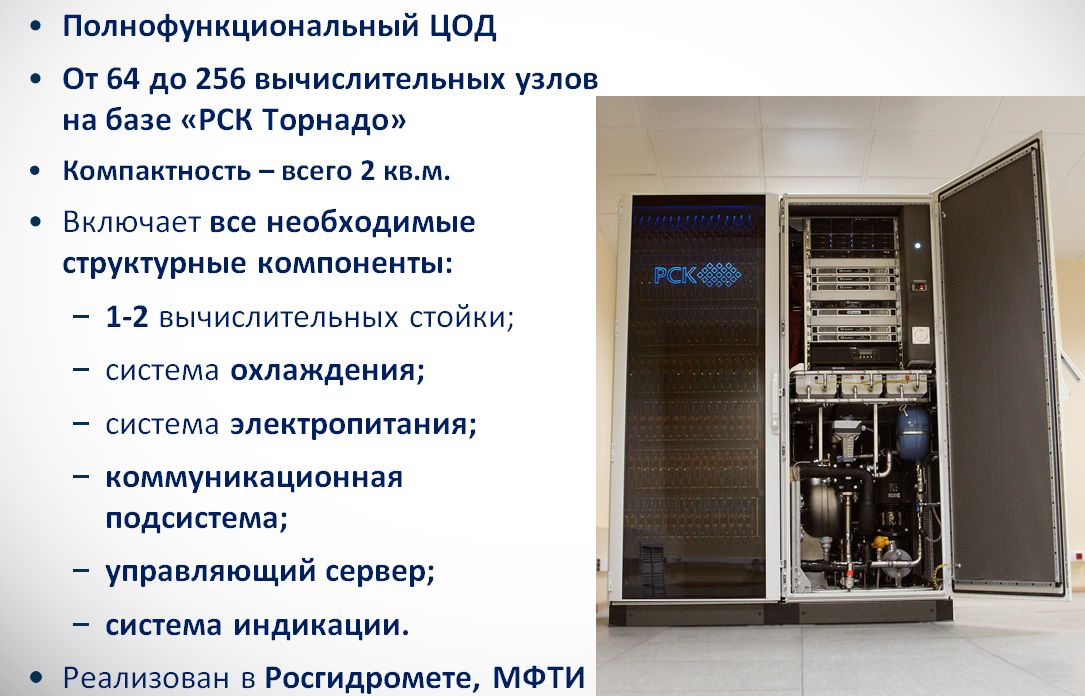
The RSC Tornado architecture uses liquid cooling for standard Intel server boards originally designed for air-blowing systems. Thanks to liquid cooling, a high energy efficiency indicator (PUE) is achieved - no more than 20% of the energy consumed is spent on cooling. Liquid cooling makes the system quieter and much more compact: the mini-data center is located in two enclosures, covering an area of about 2 square meters. m. Air cooling is left only for those components where liquid is not economically feasible. A similar system with a slightly smaller number of DGC nodes was launched at Roshydromet.

RSK produces several lines of equipment based on its RSK Tornado complex - for micro-data centers (16-64 servers), mini-data centers (64-256 servers) and for large-scale data centers with hundreds of servers.
Chinese Huawei has developed a whole line of micro and mini data centers.
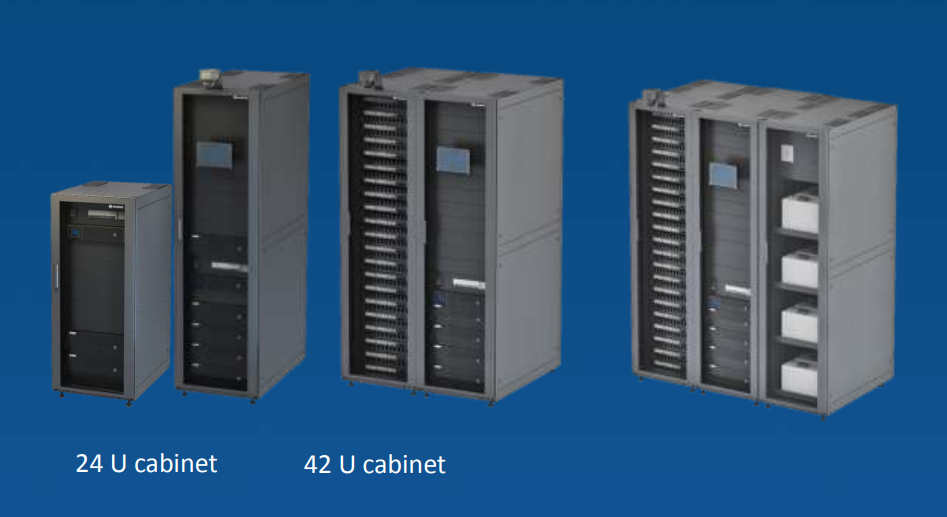
The Huawei FusionModule 500 converged mini-data center includes 1-2 cabinets for placing equipment up to 4 kW per rack, redundant UPSs designed for stand-alone operation for 15–240 min, integrated power monitoring and distribution systems, and a remote control system battery control.
For example, the Huawei FusionModule 500 can be used to place equipment in small offices, organize communication nodes of remote offices, branches and representative offices, create switching centers, dispatch and monitoring centers, situation centers and communication centers. There is also a more powerful option - Huawei FusionModule 800.

Huawei FusionModule 800 - a typical solution of 1-8 cabinets (up to 15 kW per rack) with a UPS (with N + N redundancy), integrated monitoring and distribution systems, remote battery monitoring and air conditioning with 10% load (and N + N reservations).
Softline, in partnership with GreenMDC, offered the “Modular Data Center as a Service” service from Softline. It involves the production of a modular data center to meet customer needs, its delivery, installation and connection at the customer’s site, followed by technical support on a monthly rental basis. The client receives a ready-made solution within 4-5 months. The service involves several configuration options for modular data centers from GreenMDC: from 6 to 10 cabinets and mini-data centers with the number of racks from 1 to 6.
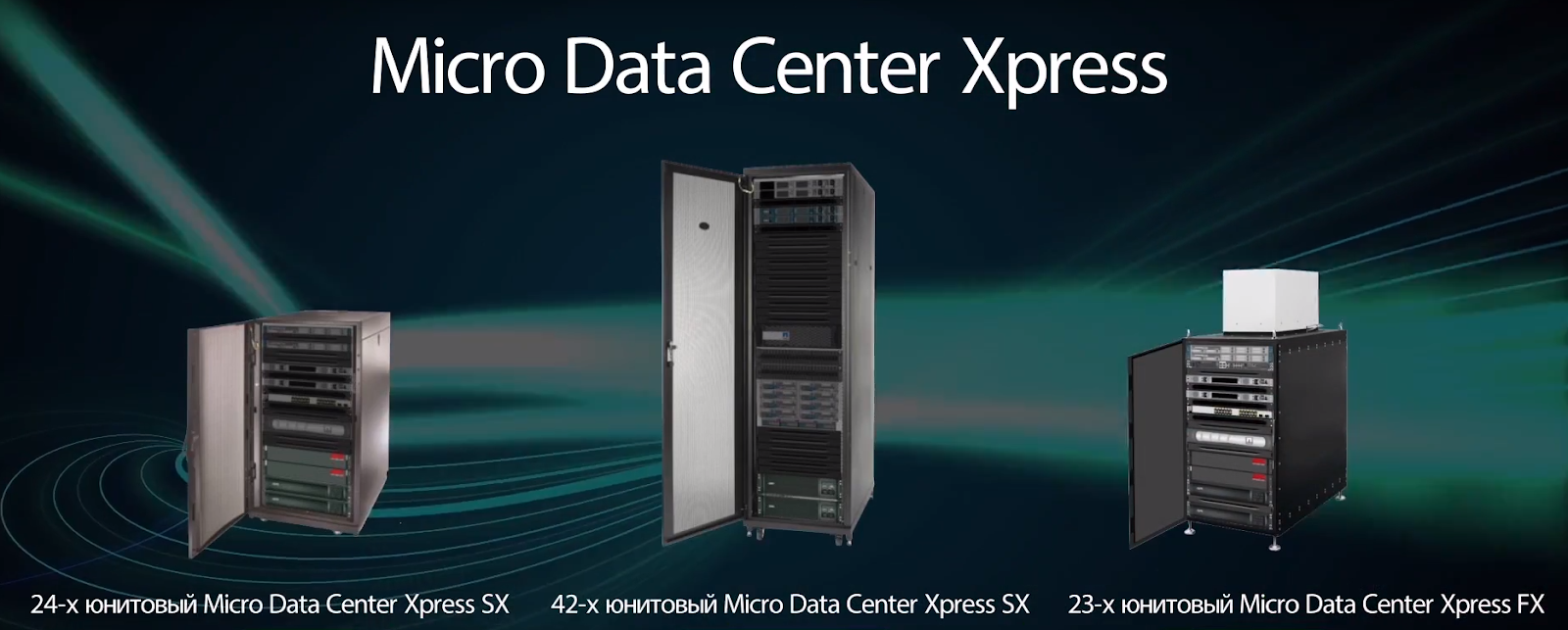
Micro Data Center Xpress line by Schneider Electric.
How miniature can a data center be? Australian Zellabox introduced Cubb micro data centers in 12U design. The developers claim that such a solution will be of interest to companies that solve the problems of data migration to the cloud, and companies that need to store data on their site and / or be able to temporarily "transfer" them to the cloud.

Zellabox Cubb is responsible for power, air quality and temperature. In addition, it provides security with a 24/7 monitoring system that works even in the event of a network failure. The modular solution allows you to combine several of these micro-data centers into a single complex.
The Zellabox micro-data center outperformed the Schneider Electric 23U SmartBunker and The System from Rittal by 15U in compactness.
Rittal offers compact Freon-cooled micro data centers with LCU (Liquid Cooling Unit) DX, Freon or Water-cooled LCP (Liquid Cooling Package) options and modular safes with all the infrastructure inside.
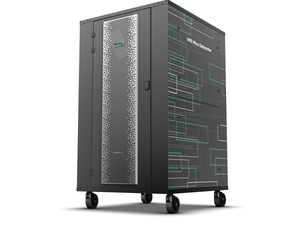
HPE Micro Datacenter is a mid-density solution that delivers 8 kW of power and cooling.
HPE Micro Datacenter provides an integrated solution with the Helion Cloud reference software architecture. It includes computing, network infrastructure, storage, management tools, DCIM. The solution is based on Schneider Electric StruxureWare. HPE OneView software provides an integrated, automated IT management environment.
The use of mini-data centers can be justified not only in small companies, often there are no professional specialists, but also in government agencies and in large businesses, where information is one of the most valuable assets. Typical applications of micro-data centers are server room replacement, private cloud infrastructure.
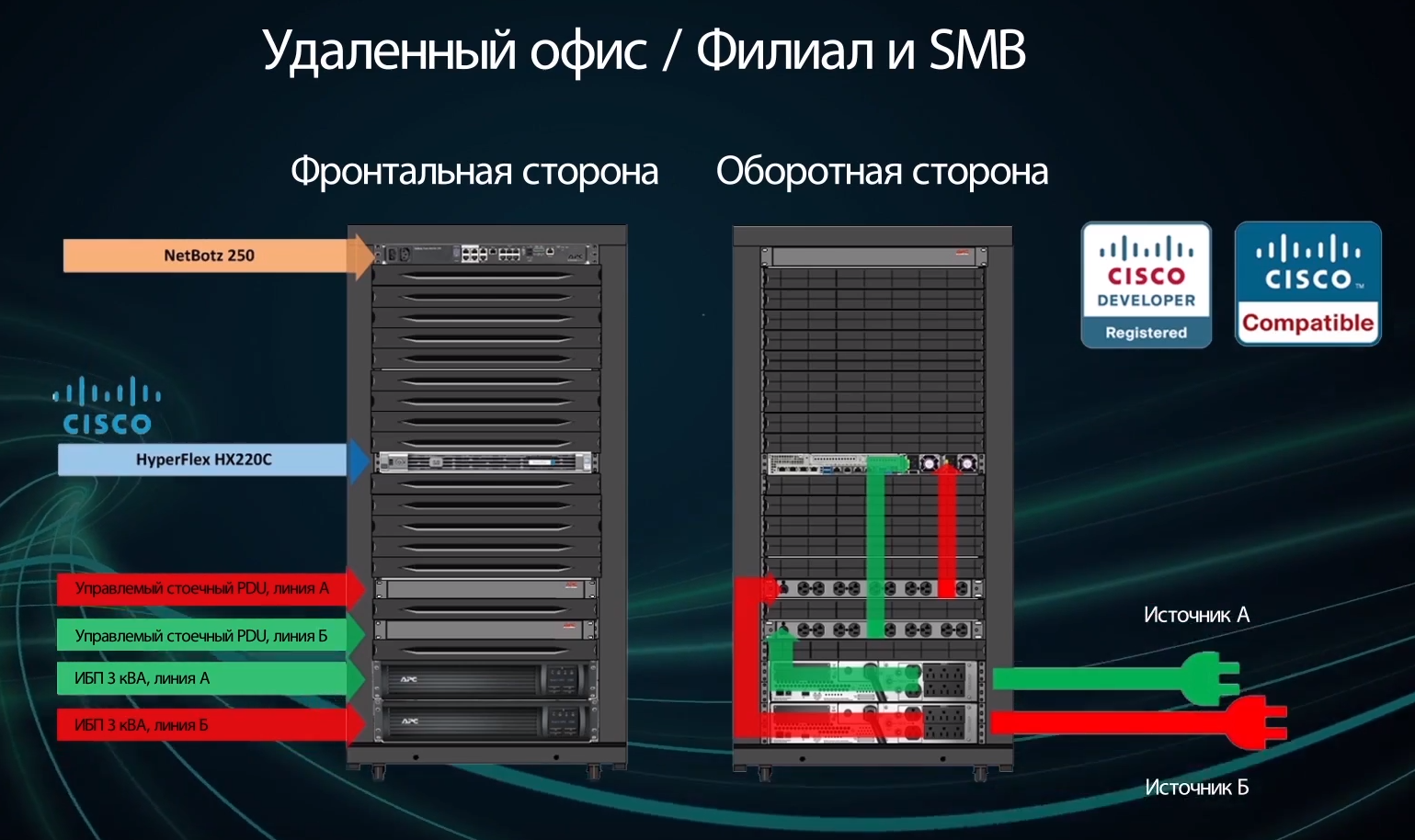

Examples of deploying Schneider Elecrtic micro-data centers at the company’s branch in SMB and in the enterprise.
There are quite unique solutions. So, the RSK mini-data center with liquid cooling allowed the creation of the Roshydromet computing cluster, which has a low level of energy consumption in combination with a high rate of energy efficiency and high computational efficiency.

RSK mini-data center at MIPT.
Meanwhile, the application areas of mini-data centers are very wide. For example, the Huawei FusionModule 500 mini data centers were used to inform primary education in Xinjiang Province (PRC) - to build a new information platform for learning in more than 60 educational institutions. This allowed us to quickly deploy a large number of systems before the start of the school year in the absence of qualified personnel in the field.
With over 3,000 branches, China's Rural Credit Cooperatives Union has implemented centralized monitoring and control through the FusionModule 500 mini-data center to reduce system operating costs. A large supermarket chain in France provided centralized monitoring and unified management of nodes located in more than 1,500 supermarkets.

Schneider Electric, a modular mini-data center designed to meet individual customer requirements, is installed in the Sagrada Familia in Barcelona. The creation of a mini data center required minimal installation at the site of operation, which avoided interference with visitors and construction. The micro-data processing center meets the requirements for portability and adaptability and does not cause inconvenience to tourists, nor does it interfere with the construction and operation of the building as an existing church. This micro data center has received the DatacenterDynamics Award.
In 2016, the Yulmart company built a new format fulfillment center in St. Petersburg. The property has a total area of 52,000 sq.m. combines a warehouse complex and a customer service area. As part of this project, the specialists of the Russian company GreenMDC installed a mini-data center CUBiC, designed to install one rack with an energy consumption of up to 5 kW. CUBiC has been working in the Order Execution Center as the main data center for three months. In the initial stages, this power was enough. Later, after the commissioning of the TelecomOutdoor NGm modular data center, auxiliary equipment was placed in the CUBiC, and it continues to fulfill its role as a mini data center.
The use of mini-data centers can be justified not only in small companies, where often there are no professional specialists, but also in government agencies and in large businesses, where information is one of the most valuable assets. Many customers are interested in micro-data center projects. The cost of designing, supplying and commissioning such a data center is comparable to organizing a data center in an existing room. The micro-data center can be placed in a warehouse or directly in the workshop, reduce the dependence on data networks from factories or from external Internet channels.


Scopes of micro- and mini-data centers (according to Schneider Electric).
These quickly deployed integrated solutions were not destined to revolutionize the construction of data centers: their application remained niche. Realizations of micro- and mini-data centers in our country are single. However, digital information, the Internet of things and boundary computing, interest in modular convergent / hyperconverged platforms and clouds - all this can give this direction new incentives for development.

What is a mini data center?
A micro (mini) data center is a complex consisting of one (micro data center) or several interconnected (mini data centers) racks, equipped with all the infrastructure necessary for the operation of IT equipment and pre-assembled and tested by the manufacturer.
These data centers are mainly designed to accommodate computing power and telecommunications equipment in unprepared premises, such as offices, warehouses, utility rooms or industrial premises. According to the vendors, the installation time for their use is reduced to 60-70% compared with the classic solution.

Over the past decade, micro-data centers in a container have been developed by leading foreign manufacturers (mainly suppliers of server hardware) and a number of domestic system integrators.
The advantages of micro-data centers, many of which can be placed in a small cabinet, are also attributed by the manufacturers to configuration flexibility, usually meaning the possibility of creating a customized solution to customer requirements, and the shortest time for manufacturing and delivery. This is a comprehensive product, a solution “from one source”: all the elements necessary for installation are included in the delivery package, which eliminates the complexity of installation, commissioning and integration. Equipment from one manufacturer (or partners) provides a high degree of system integration. In addition, such a kit undergoes preliminary testing of systems before being sent to the customer.
Growth drivers

Trends in the development of the global mini-data center market (according to MarketsandMarkets). The projected market growth is up to $ 6.3 billion in 2020. The growth rate is up to 29.8% per year. Largest markets: North America, China, India, Brazil.
Abroad, this direction is considered quite promising. Allegedly, such complexes are in great demand in the West. So, given the progress in the field of the Internet of Things (IoT), micro-data centers are becoming an interesting tool for processing data generated by IoT solutions. Placing a micro-data center near a data source reduces transmission delays and network bandwidth requirements, which is important when there is a rapid increase in the number of devices connected to the network.

Boundary computing platforms, the role of which micro-data centers can play, allow you to distribute the load and bring computing power closer to the data source, reduce network latency.
Micro data centers are designed to minimize capital costs, optimize data center space utilization and energy consumption, and increase deployment speed. Several trends have led to this architecture:
- Increased hardware density: Virtualized IT hardware in cloud architectures that previously required 10 racks can now fit into one.
- Convergence and integration: servers, data warehousing, network equipment and software are integrated and validated by the vendor, delivered as a ready-made solution “out of the box”.
- Network latency : the need to reduce latency between data centers (like the cloud) and applications.
- Deployment Speed: Reducing the deployment time of a solution sometimes provides a competitive advantage.
- Cost reduction: in many cases, micro-data centers can use excess power, which for one reason or another is not used. This underutilization is a common problem in corporate data centers.
- Optimization of cloud services: micro-data centers play a key role in optimizing the performance and usefulness of mobile and other network devices when accessing the cloud.
How does it work?
Often, micro-data centers are equipped with built-in uninterruptible power supplies (UPS) and infrastructure management software packages (DCIM). These solutions can be deployed both in ordinary offices and in more aggressive environments.

Micro- and mini-data centers belong to the category of small systems.
Usually, each of them includes the cabinet itself, as well as cooling, monitoring, fire extinguishing, power management and protection systems. This is a kind of autonomous data center, characterized by a high level of security and sufficient cooling capacity. And thanks to the lightweight design, such a mini-data center can be installed in places with low bearing capacity of floors.

The main elements of the micro- (mini-) data center (according to Huawei): fire extinguishing, cooling, monitoring, UPS, power distribution, input-output, security subsystem.
The micro-data center may also contain: a power distribution system with “smart” PDUs (in addition to actually measuring energy consumption, they can support temperature and humidity sensors in the rack), an automatic gas fire extinguishing system, an access control and management system (ACS) and other systems (in depending on the supplier).
Execution may be different. For example, Rittal's modular micro data centers are real safes. They protect against fire, liquids, dust, breaking and corrosive gases. The safe is supplied with an air conditioning system installed at the factory, an optional system based on inverter technology is delivered, which allows you to save up to 40% of energy by adjusting the power according to need. If necessary, the safe can be additionally equipped with alarm systems, fire extinguishing, uninterruptible power supply, monitoring, etc.

Rittal Modular Micro Data Center. The developers attribute the following to its advantages:
1. Saving costs and time (there is no need to equip the available space in the building to the level of the server room);
2. Flexibility (modular layout, suitable even for hard-to-reach objects).
3. Long-term investments (opportunities for reassembly and transportation);
4. Physical protection (the solution provides protection against fire, water, dust, smoke and external access);
5. Effective cooling with well-thought-out routing of air flows and temperature control at the inlet to the server, adjustable inverter output power);
6. Fire alarm and active fire fighting in the server rack;
7. Reliable monitoring.
A small data center can also be assembled from a series of cabinets, on the basis of which it is easy to organize a server, micro-data center for a small company, and a mini data center for an average organization.
Since critical IT services can be deployed on the basis of micro-data centers, a high level of fault tolerance can be ensured, in particular, all major engineering systems (power supply, cooling) can be backed up according to the N + 1 scheme (and higher). The office complex where the micro-data center is deployed may not be equipped with a backup DGU, therefore, the micro-data center must provide autonomous power in the event of an accident for 10-30 minutes.

Micro data center is an autonomous, secure computing system, assembled and tested in the factory. Such data centers supplied include all the necessary equipment to provide power, cooling, security and management tools (DCIM).
Micro data center developers use different cooling technologies. Usually they proceed from the condition of minimizing the area occupied by the cooling system, as well as reducing the total cost of ownership and improving energy efficiency.

The main global manufacturers of mini- and micro-data centers (according to the agency MarketsandMarkets).
In order to constructively look like a single complex, engineering equipment of micro-data centers is usually placed in the same racks as IT systems. It is also possible to install elements of engineering infrastructure, such as a UPS, in the same racks with IT equipment. At the same time, designers are trying to minimize the space occupied by engineering systems, including UPS, battery, cooling system.
Advantages and disadvantages of micro- and mini-data centers
Among the advantages of the solutions under consideration include scalability, compactness and energy efficiency, rapid deployment, simple management, security. This is a standardized solution, an economical solution.
An important advantage of micro-data centers is the ability to deploy additional computing power in ordinary offices and at other sites without specialized supporting infrastructure. This reduces the capital costs associated with the expansion of existing data centers.
We list the main advantages of such solutions (according to Huawei).
| Advantages | disadvantages |
|---|---|
| Possibility of installation in unprepared rooms | Need for maintenance and uptime |
| The ability to place equipment in regions where the necessary data center capacities are not available | The need for IT staff |
| Relatively low cost | Initial costs are higher than placement in a rented commercial data center |
| High Deployment Speed | Production and installation time is longer than the transition to leased data center capacities |
| Ability to move to another site | Limited expansion options |
| Minimum floor space | Less flexibility than traditional solutions |
The micro-data center can be delivered to the operating site with racks, UPSs, energy distribution, cooling and control systems in a pre-installed form and ready for deployment.
Solution Examples
Over the past decade, a number of interesting developments in the field of mini- and micro-data centers have been presented on the Russian market.

Russian-made micro-data centers are developed by ETegro Technologies, Svyaz Engineering and Utileks.
For example, ETegro micro-data center is built on the basis of the DataStone + modular solution and combines 19-inch racks with integrated Utverlex Clever Breeze air conditioning systems. A typical micro-data center solution consists of two 42U noise-proof sealed enclosures with inter-row precision air conditioners located between them.
This is a closed, sealed, soundproofed complex with protection class IP65.
IT infrastructure - ETegro Hyperion servers, ETegro Fastor storage systems and ETegro Eos switches. The system uses double conversion UPSs of Svyaz Engineering, the battery life is 15 minutes. System redundancy level N + 1. This decision was announced in 2015 as an effective and economical way to create a private cloud or a ready-made IT infrastructure for small enterprises, branches and representative offices of geographically distributed companies. As the creators promised, the creation of a completely ready-to-operate infrastructure anywhere in Russia will require no more than 12 weeks.
In subsequent years, based on the development experience of this typical micro data center, Utilexcreated a whole line of mini and micro data centers. These are mainly modular systems with the possibility of further expansion. Among them is the DataStone Mini “supermicro-data center”, designed to accommodate any 19-inch IT equipment up to 27U and power up to 2.5 kW. It has a protection class - IP54, noise isolation (18 dBA), and the cooling system is implemented on the basis of built-in fans with dust filters. There is also the possibility of installing a remote monitoring system via TCP / IP, SNMP, RS485 (Modbus RTU).

Applications DataStone Mini - server room replacement, private cloud infrastructure.
The advantages of this solution, developers include saving capital costs, short deadlines for creating a data center, high fault tolerance, the ability to move it and remote control.

Utilex DataStone + modular micro-data center is designed to accommodate and provide the required availability of computing, network equipment, storage systems, as well as any active and passive equipment. The solution with protection class IP65 has a closed cooling system (it is possible to build a cooling system with full 2N redundancy) and supports up to 30 kW of IT load per cabinet.
The RSK Tornado mini-data center also includes all the necessary structural components: 1-2 computing racks (with Intel processors, Infiniband interconnect), a cooling and power supply system, a communication subsystem, a control server and an indication system (a pump station, station is located in an adjacent cabinet water treatment, network equipment and storage). Such systems are deployed at Roshydromet, MIPT. Preparation of premises for them is not required.

The RSC Tornado architecture uses liquid cooling for standard Intel server boards originally designed for air-blowing systems. Thanks to liquid cooling, a high energy efficiency indicator (PUE) is achieved - no more than 20% of the energy consumed is spent on cooling. Liquid cooling makes the system quieter and much more compact: the mini-data center is located in two enclosures, covering an area of about 2 square meters. m. Air cooling is left only for those components where liquid is not economically feasible. A similar system with a slightly smaller number of DGC nodes was launched at Roshydromet.

RSK produces several lines of equipment based on its RSK Tornado complex - for micro-data centers (16-64 servers), mini-data centers (64-256 servers) and for large-scale data centers with hundreds of servers.
Chinese Huawei has developed a whole line of micro and mini data centers.

The Huawei FusionModule 500 converged mini-data center includes 1-2 cabinets for placing equipment up to 4 kW per rack, redundant UPSs designed for stand-alone operation for 15–240 min, integrated power monitoring and distribution systems, and a remote control system battery control.
For example, the Huawei FusionModule 500 can be used to place equipment in small offices, organize communication nodes of remote offices, branches and representative offices, create switching centers, dispatch and monitoring centers, situation centers and communication centers. There is also a more powerful option - Huawei FusionModule 800.

Huawei FusionModule 800 - a typical solution of 1-8 cabinets (up to 15 kW per rack) with a UPS (with N + N redundancy), integrated monitoring and distribution systems, remote battery monitoring and air conditioning with 10% load (and N + N reservations).
Softline, in partnership with GreenMDC, offered the “Modular Data Center as a Service” service from Softline. It involves the production of a modular data center to meet customer needs, its delivery, installation and connection at the customer’s site, followed by technical support on a monthly rental basis. The client receives a ready-made solution within 4-5 months. The service involves several configuration options for modular data centers from GreenMDC: from 6 to 10 cabinets and mini-data centers with the number of racks from 1 to 6.

Micro Data Center Xpress line by Schneider Electric.
How miniature can a data center be? Australian Zellabox introduced Cubb micro data centers in 12U design. The developers claim that such a solution will be of interest to companies that solve the problems of data migration to the cloud, and companies that need to store data on their site and / or be able to temporarily "transfer" them to the cloud.

Zellabox Cubb is responsible for power, air quality and temperature. In addition, it provides security with a 24/7 monitoring system that works even in the event of a network failure. The modular solution allows you to combine several of these micro-data centers into a single complex.
The Zellabox micro-data center outperformed the Schneider Electric 23U SmartBunker and The System from Rittal by 15U in compactness.
Rittal offers compact Freon-cooled micro data centers with LCU (Liquid Cooling Unit) DX, Freon or Water-cooled LCP (Liquid Cooling Package) options and modular safes with all the infrastructure inside.

HPE Micro Datacenter is a mid-density solution that delivers 8 kW of power and cooling.
HPE Micro Datacenter provides an integrated solution with the Helion Cloud reference software architecture. It includes computing, network infrastructure, storage, management tools, DCIM. The solution is based on Schneider Electric StruxureWare. HPE OneView software provides an integrated, automated IT management environment.
Mini Data Center Examples
The use of mini-data centers can be justified not only in small companies, often there are no professional specialists, but also in government agencies and in large businesses, where information is one of the most valuable assets. Typical applications of micro-data centers are server room replacement, private cloud infrastructure.


Examples of deploying Schneider Elecrtic micro-data centers at the company’s branch in SMB and in the enterprise.
There are quite unique solutions. So, the RSK mini-data center with liquid cooling allowed the creation of the Roshydromet computing cluster, which has a low level of energy consumption in combination with a high rate of energy efficiency and high computational efficiency.

RSK mini-data center at MIPT.
Meanwhile, the application areas of mini-data centers are very wide. For example, the Huawei FusionModule 500 mini data centers were used to inform primary education in Xinjiang Province (PRC) - to build a new information platform for learning in more than 60 educational institutions. This allowed us to quickly deploy a large number of systems before the start of the school year in the absence of qualified personnel in the field.
With over 3,000 branches, China's Rural Credit Cooperatives Union has implemented centralized monitoring and control through the FusionModule 500 mini-data center to reduce system operating costs. A large supermarket chain in France provided centralized monitoring and unified management of nodes located in more than 1,500 supermarkets.

Schneider Electric, a modular mini-data center designed to meet individual customer requirements, is installed in the Sagrada Familia in Barcelona. The creation of a mini data center required minimal installation at the site of operation, which avoided interference with visitors and construction. The micro-data processing center meets the requirements for portability and adaptability and does not cause inconvenience to tourists, nor does it interfere with the construction and operation of the building as an existing church. This micro data center has received the DatacenterDynamics Award.
In 2016, the Yulmart company built a new format fulfillment center in St. Petersburg. The property has a total area of 52,000 sq.m. combines a warehouse complex and a customer service area. As part of this project, the specialists of the Russian company GreenMDC installed a mini-data center CUBiC, designed to install one rack with an energy consumption of up to 5 kW. CUBiC has been working in the Order Execution Center as the main data center for three months. In the initial stages, this power was enough. Later, after the commissioning of the TelecomOutdoor NGm modular data center, auxiliary equipment was placed in the CUBiC, and it continues to fulfill its role as a mini data center.
Who needs this?
The use of mini-data centers can be justified not only in small companies, where often there are no professional specialists, but also in government agencies and in large businesses, where information is one of the most valuable assets. Many customers are interested in micro-data center projects. The cost of designing, supplying and commissioning such a data center is comparable to organizing a data center in an existing room. The micro-data center can be placed in a warehouse or directly in the workshop, reduce the dependence on data networks from factories or from external Internet channels.


Scopes of micro- and mini-data centers (according to Schneider Electric).
These quickly deployed integrated solutions were not destined to revolutionize the construction of data centers: their application remained niche. Realizations of micro- and mini-data centers in our country are single. However, digital information, the Internet of things and boundary computing, interest in modular convergent / hyperconverged platforms and clouds - all this can give this direction new incentives for development.
